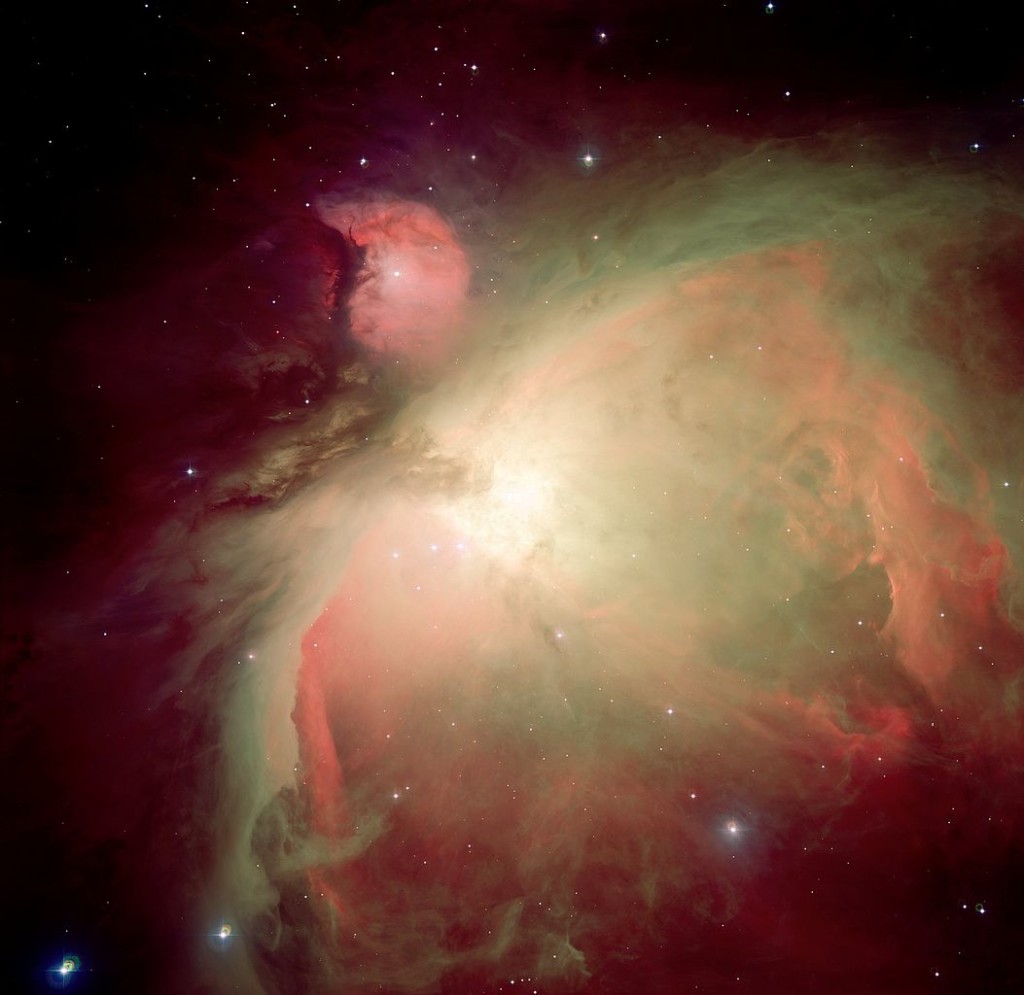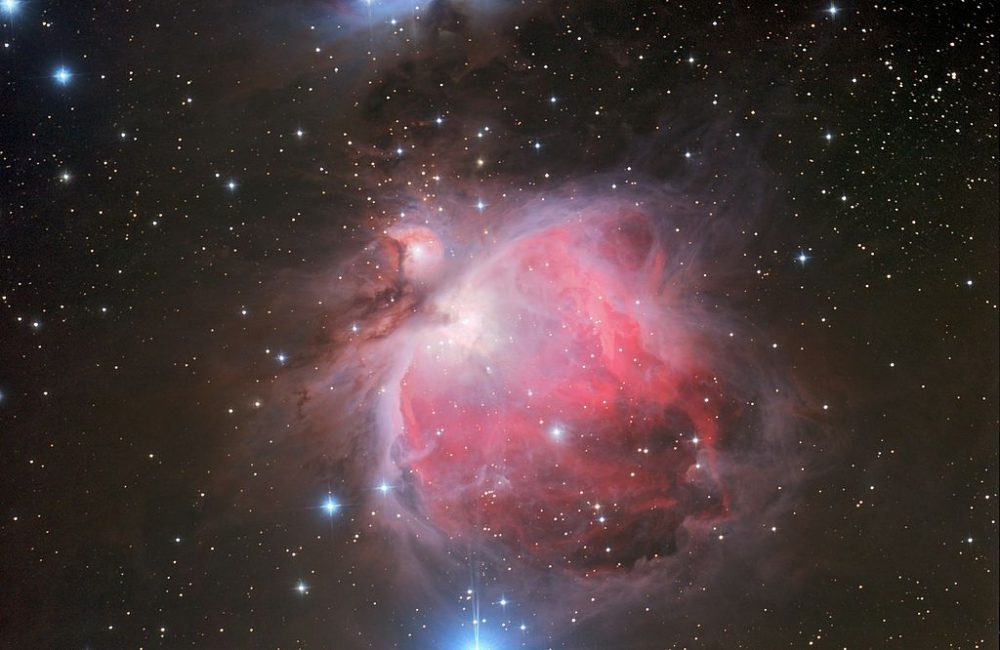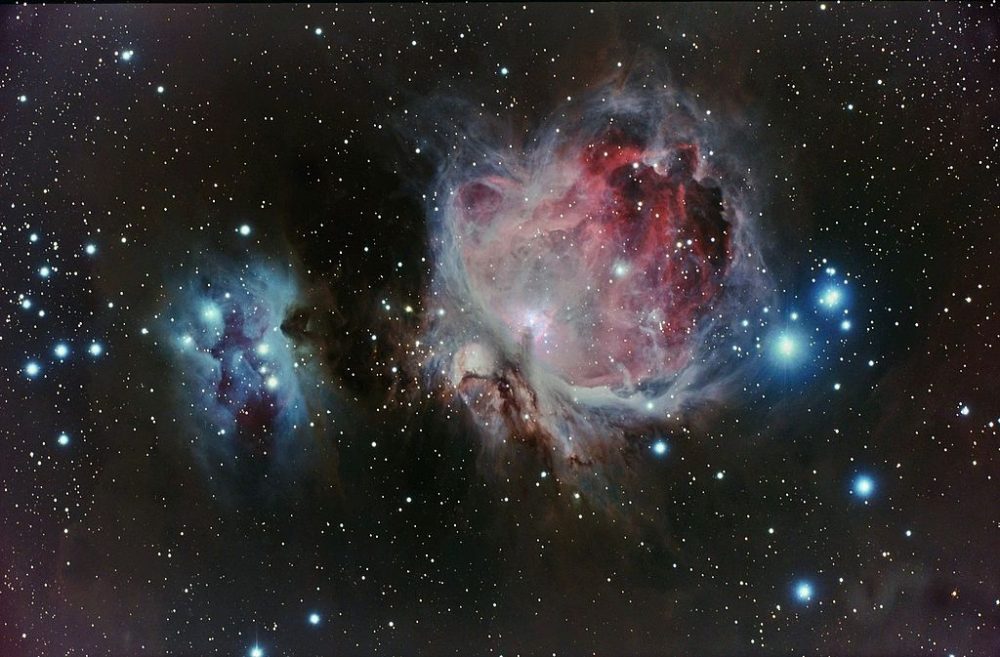The Orion Nebula is a famous diffuse emission/reflection nebula located in the constellation Orion. It is also known as Messier 42 (M42) or the Great Orion Nebula. Its designation in the New General Catalogue is NGC 1976.
The brightest stars in the nebula form an asterism known as the Trapezium Cluster. These young stars are responsible for most of the nebula’s glow.
The Orion Nebula is one of the brightest nebulae in the night sky and, lying at a distance of 1,344 light years, it is the nearest region of massive star formation to Earth. It can be seen without binoculars, and its brightness and proximity make M42 one of the most studied objects in the night sky.
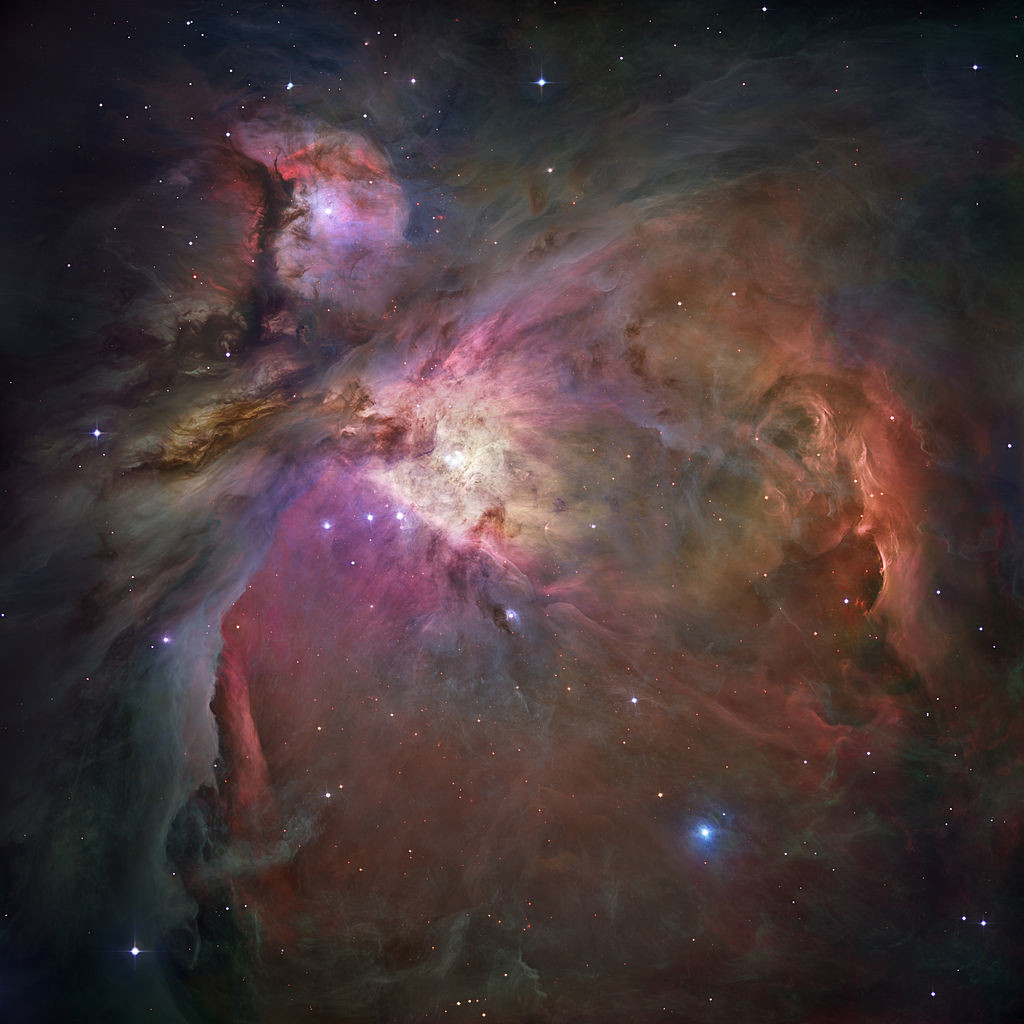
Orion Nebula (Messier 42) – In one of the most detailed astronomical images ever produced, NASA’s Hubble Space Telescope captured an unprecedented look at the Orion Nebula. This turbulent star formation region is one of astronomy’s most dramatic and photogenic celestial objects. More than 3,000 stars of various sizes appear in this image. Some of them have never been seen in visible light. These stars reside in a dramatic dust-and-gas landscape of plateaus, mountains, and valleys that are reminiscent of the Grand Canyon. The Orion Nebula is a picture book of star formation, from the massive, young stars that are shaping the nebula to the pillars of dense gas that may be the homes of budding stars. Image: NASA, ESA, Hubble
The nebulous region of M42 is easily seen through binoculars or a small telescope. The best time of year to observe the nebula is the winter, during the months of December and January, when Orion constellation is high in the sky.
Astronomers studying the nebula have learned a lot about the formation of stars and planetary systems from collapsing dust and gas clouds, and they have observed the effects of massive stars photo-ionizing the clouds in the nebula. They have also discovered what they believe are some of the younger protostars ever found.
The Orion Nebula spans a degree in the sky, and includes stellar associations, reflection nebulae, dust and gas clouds, and ionized volumes of gas.
FACTS AND LOCATION
The Orion Nebula lies at a distance of 1,344 light years (400 parsecs) from Earth, and can be found in the constellation Orion, to the south of Orion’s Belt, one of the best known asterisms in the night sky.
The nebula is located in the sword of Orion and appears as the middle, slightly fuzzy-looking “star” in the sword to the unaided eye. Binoculars and small telescopes reveal a cloudy patch of light.
Orion’s Sword can be found by locating the three stars of Orion’s Belt, and then following the curved line of stars that appear to be hanging from the Hunter’s belt. These stars mark Orion’s Sword, and the Orion Nebula appears as the middle star in the sword when seen without binoculars.
Messier 42 is about 24 light years across and has an estimated mass approximately 2,000 times that of the Sun. It is the brighest part of a huge star-forming region, and the nearest region of massive star formation to Earth. The nebula is believed to contain more than 1,000 young stars, and about 700 stars that are still in various phases of formation.
M42 is part of a much larger nebulous region known as the Orion Molecular Cloud Complex, which extends across the Orion constellation and includes a number of famous deep sky objects, among them Barnard’s Loop, the Flame Nebula, the Horsehead Nebula, Messier 43, and Messier 78.
The Orion Nebula was first discovered by the French astronomer Nicolas-Claude Fabri de Peiresc on November 26, 1610. He observed the nebulous region using a refracting telescope.
In 1619, the Swiss Jesuit astronomer and mathematician Johann Baptist Cysat observed the nebula and compared it to a bright comet discovered in 1618. This was the first published observation of the Orion Nebula. The first published sketch was made by the Dutch astronomer and physicist Christiaan Huygens in 1659.
The nebula is home to a well-known young open star cluster, the Trapezium Cluster.
Charles Messier observed the Orion Nebula on March 4, 1769. He also noted three stars belonging to the Trapezium Cluster. When he published the first edition of his catalogue in 1774, the nebula was listed as the 42nd object. It is still known as Messier 42.
The credit for the first ever instance of astrophotography of the nebula – of any nebula – goes to the American doctor, amateur astronomer and astrophotography pioneer Henry Draper, who photographed Messier 42 using an 11-inch refractor to make a 51-minute exposure of the nebula on September 30, 1880.
The Orion Nebula was first observed by the Hubble Space Telescope in 1993, and has been a frequent target since.
Orion Nebula – Messier 42
Constellation: Orion
Coordinates: 05h35m17.3s (right ascension), -05°23’28” (declination)
Visual magnitude: +4.0
Absolute magnitude: -4.1
Apparent dimensions: 65×60 arc minutes
Radius: 12 light years
Designations: Messier 42 (M42), NGC 1976, LBN 974, Sharpless 281
TRAPEZIUM CLUSTER
The Trapezium Cluster is a young open cluster located in the Orion Nebula. The brightest four stars in the cluster form an asterism shaped like a trapezium, a quadrilateral with a pair of parallel sides. In a 5-inch telescope, six stars can be observed in good viewing conditions.
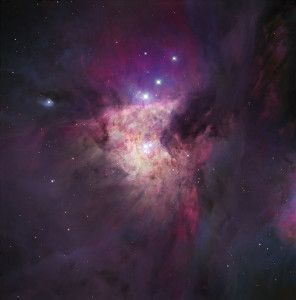
The Orion Nebula is arguably the finest of all nebulae within the Milky Way visible from the Northern Hemisphere. With a gaseous repository of 10,000 suns, and illuminated by a cluster of hot young stars, the clouds of Messier 42 — as it is also known — glow with fantastic colours and shapes, giving us a bird’s eye view of one of the greatest star forming nurseries in our part of the Milky Way. Messier 42 is a complex of glowing gas, mostly hydrogen but also helium, carbon, nitrogen, and oxygen in decreasing amounts, located 1,500 light-years away. At its very heart, we find the Trapezium, a group of four very hot stars that illuminate the nebula. They are the brightest of an extended cluster of several thousand young stars many of which lie unseen within the opaque gas and dust. Amazingly, whilst the Orion Nebula is easy to identify with the unaided eye, there is apparently no written record of its existence before the 17th century. This image is based on data acquired with the 1.5 m Danish telescope at the ESO La Silla Observatory in Chile, through three filters (B: 60 s, V: 30 s, R: 21 s). East is at the upper right corner and North is at the lower right. Image: ESO/IDA/Danish 1.5 m/R.Gendler, J.-E. Ovaldsen, and A. Hornstrup
The cluster was formed directly out of the Orion Nebula, within the edge of the Orion Molecular Cloud.
The Trapezium Cluster was discovered by the Italian mathematician, philosopher, astronomer and physicist Galileo Galilei on February 4, 1617. He spotted three of the brightest stars in the cluster, but did not see the nebulosity that surrounds them. The fourth of the main stars was not observed until 1673, and the remaining components were discovered later, totalling eight by 1888, with several of the stars revealed to be binary systems later.
The asterism was named the Trapezium Cluster by the Swiss-American astronomer Robert Julius Trumpler in 1931.
Of the four main stars in the cluster, two can be resolved into binary systems, making a total of six stars. The stars are quite young and still in an early stage of evolution. They have an estimated age of a little more than 100,000 years.
The brightest star in the cluster, Theta-1 Orionis C, has an apparent visual magnitude of 5.13. Both this star and the second brightest star are classified as eclipsing binary systems.
The brightest stars in the cluster are between 15 and 30 times as massive as the Sun and lie within 1.5 light years of each other. They illuminate the surrounding nebulous region. About half the member stars have evaporating circumstellar disks, which means that planetary systems may soon form in their orbits.
The Trapezium Cluster is suspected to be a component of the Orion Nebula Cluster, a larger association of about 2,000 stars spanning an area approximately 20 light years in diameter.
In 2012, a team of astronomers suggested that the cluster may contain an intermediate black hole, more than 100 times as massive as the Sun, at its centre.
Trapezium Cluster
Coordinates: 05h35.4m (right ascension), -05°27′ (declination)
Distance: 1,600 light years (490 parsecs)
Visual magnitude: 4.0
Apparent dimensions: 47 arc seconds
Radius: 10 light years
IMAGES
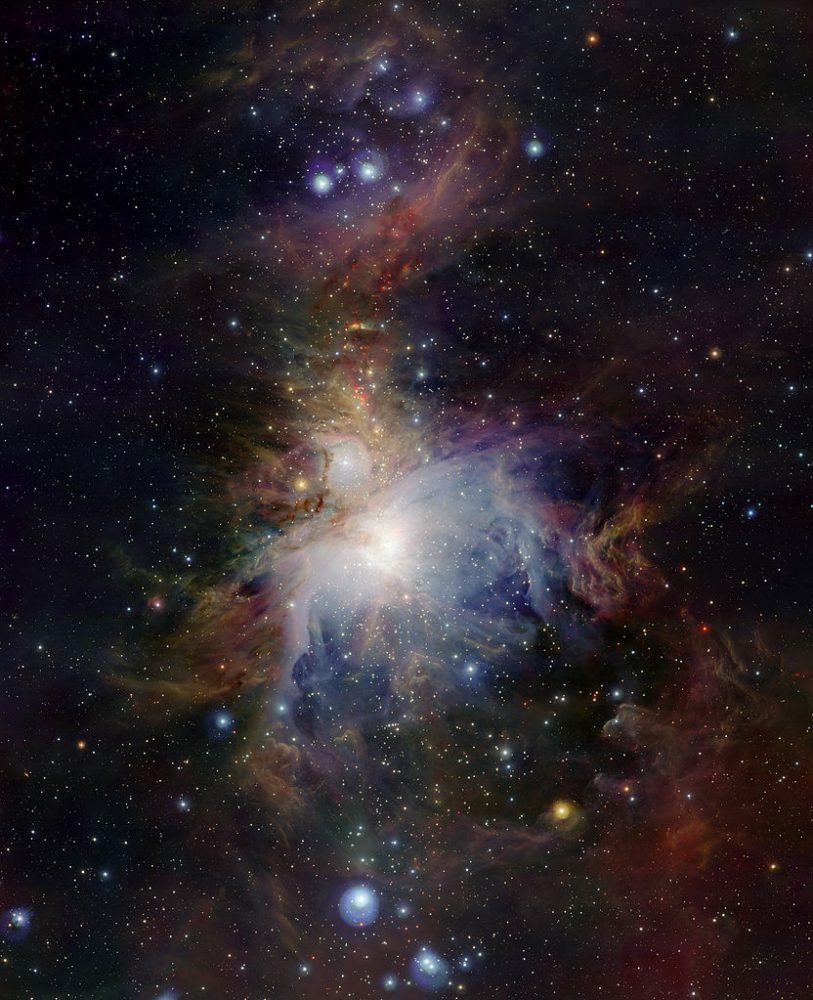
This wide-field view of the Orion Nebula (Messier 42), lying about 1350 light-years from Earth, was taken with the VISTA infrared survey telescope at ESO’s Paranal Observatory in Chile. The new telescope’s huge field of view allows the whole nebula and its surroundings to be imaged in a single picture and its infrared vision also means that it can peer deep into the normally hidden dusty regions and reveal the curious antics of the very active young stars buried there. This image was created from images taken through Z, J and Ks filters in the near-infrared part of the spectrum. The exposure times were ten minutes per filter. The image covers a region of sky about one degree by 1.5 degrees. Image: ESO/J. Emerson/VISTA. Acknowledgment: Cambridge Astronomical Survey Unit
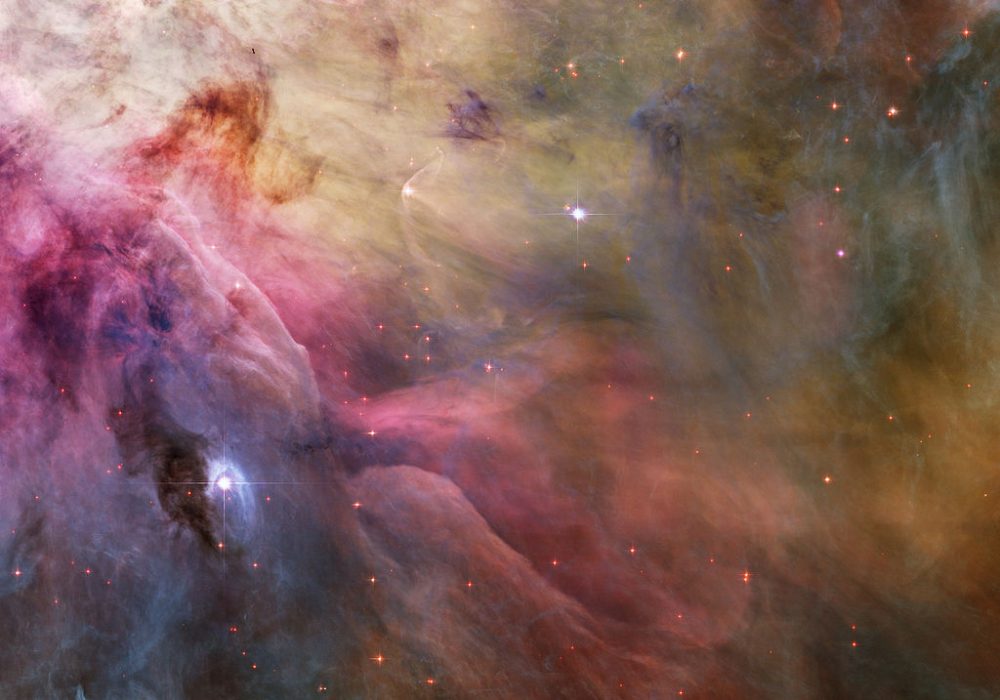
Panoramic view of part of Orion Nebula (M42, Messier 42, NGC 1976) by Hubble Space Telescope. Image: NASA, ESA, and The Hubble Heritage Team (STScI/AURA). Acknowledgment: NASA, ESA, M. Robberto (Space Telescope Science Institute) and the Hubble Space Telescope Orion Treasury Project Team
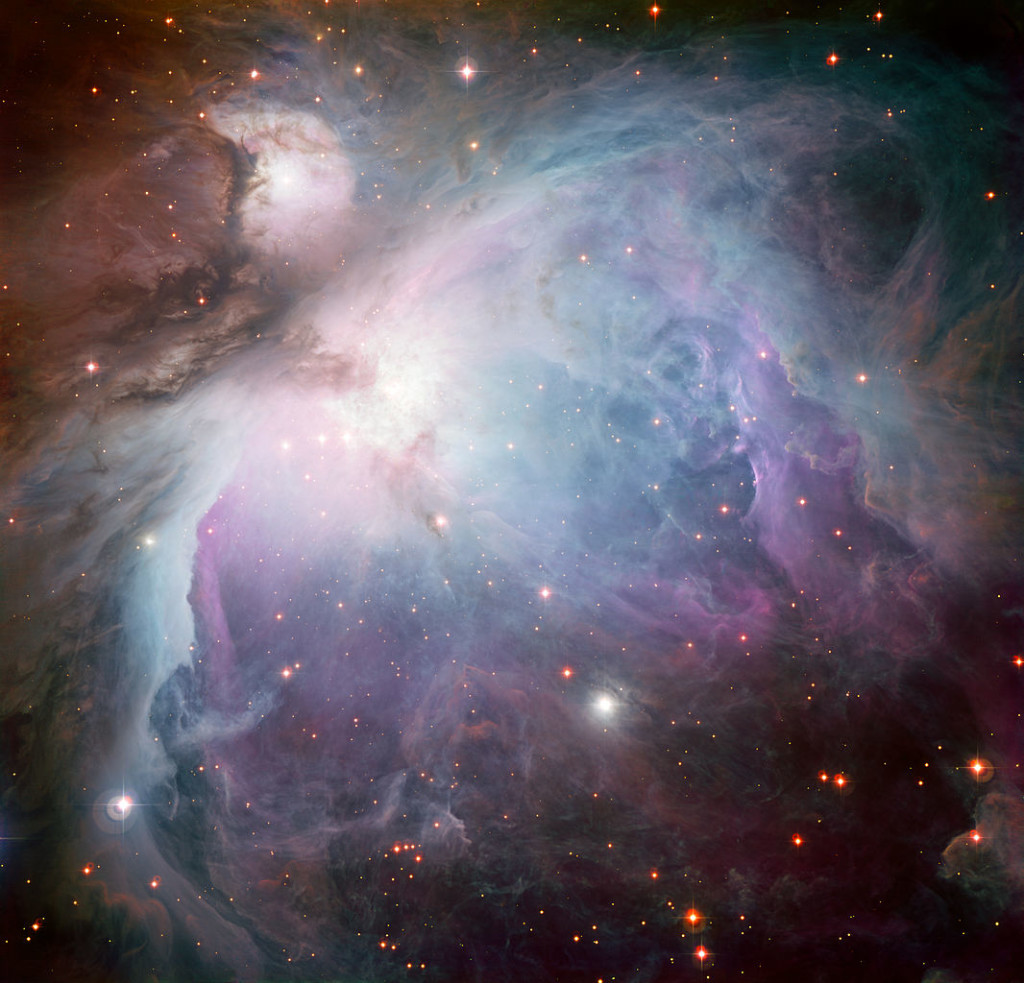
This new image of the Orion Nebula was captured using the Wide Field Imager camera on the MPG/ESO 2.2-metre telescope at the La Silla Observatory, Chile. This image is a composite of several exposures taken through a total of five different filters. Light that passed through a red filter, as well as light from a filter that shows the glowing hydrogen gas, is coloured red. Light in the yellow–green part of the spectrum is coloured green, blue light is coloured blue and light that passed through an ultraviolet filter has been coloured purple. The exposure times were about 52 minutes through each filter. Image: ESO and Igor Chekalin
VISIBLE LIGHT AND INFRARED
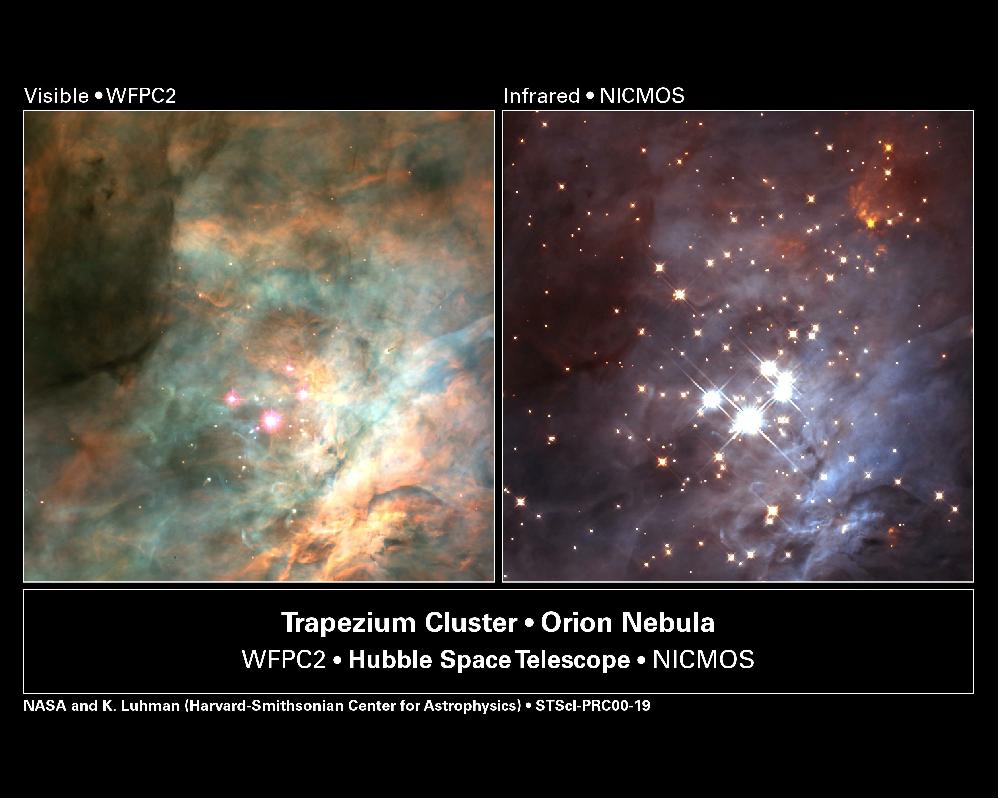
NASA image of Trapezium Cluster in Orion Nebula, Hubble Space Telescope, Visible (Left) and Infrared (Right). Image: ESA, NASA, STScI
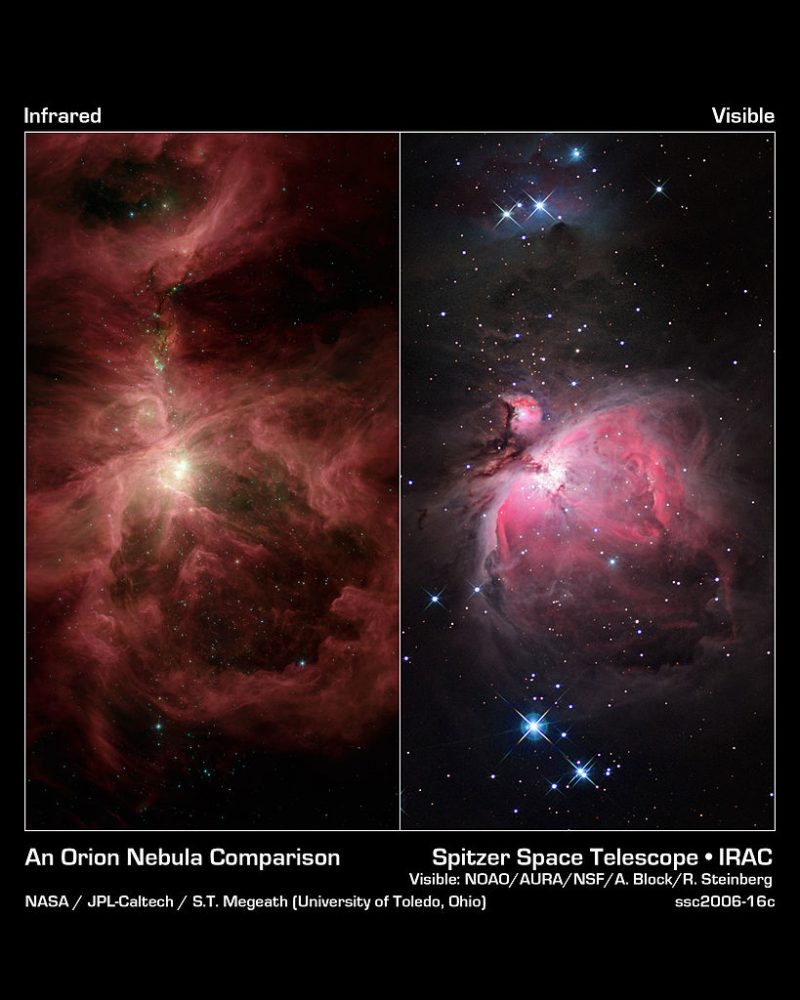
This image composite compares infrared and visible views of the famous Orion nebula and its surrounding cloud, an industrious star-making region located near the hunter constellation’s sword. The infrared picture is from NASA’s Spitzer Space Telescope, and the visible image is from the National Optical Astronomy Observatory, headquartered in Tucson, Ariz. In addition to Orion, two other nebulas can be seen in both pictures. The Orion nebula, or M42, is the largest and takes up the lower half of the images; the small nebula to the upper left of Orion is called M43; and the medium-sized nebula at the top is NGC 1977. Each nebula is marked by a ring of dust that stands out in the infrared view. These rings make up the walls of cavities that are being excavated by radiation and winds from massive stars. The visible view of the nebulas shows gas heated by ultraviolet radiation from the massive stars. Above the Orion nebula, where the massive stars have not yet ejected much of the obscuring dust, the visible image appears dark with only a faint glow. In contrast, the infrared view penetrates the dark lanes of dust, revealing bright swirling clouds and numerous developing stars. This is because infrared light can travel through dust, whereas visible light is stopped short by it. The infrared image shows light captured by Spitzer’s infrared array camera. Light with wavelengths of 8 and 5.8 microns (red and orange) comes mainly from dust that has been heated by starlight. Light of 4.5 microns (green) shows hot gas and dust; and light of 3.6 microns (blue) is from starlight. Image: Spitzer: NASA/JPL-Caltech/ T. Megeath (University of Toledo, Ohio)
X-RAY AND INFRARED
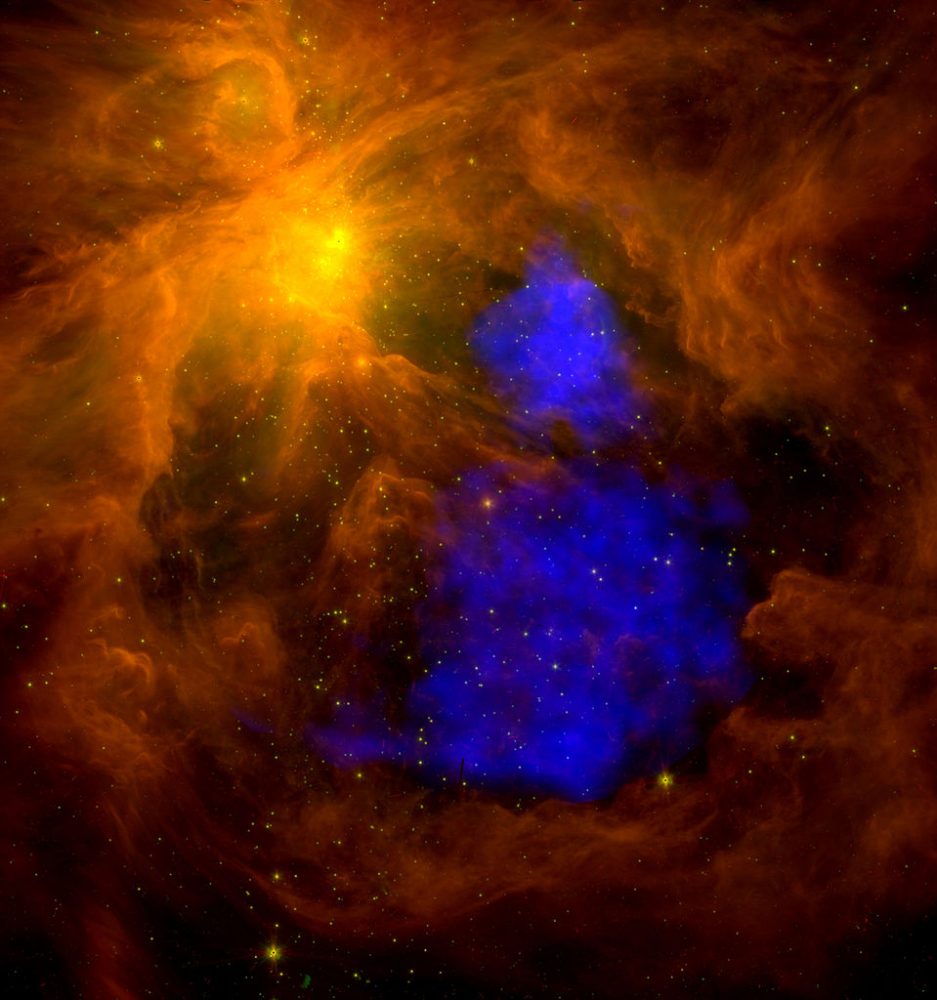
Right in time for the festive season, this image of the Orion nebula combines NASA’s Spitzer Space Telescope infrared light with X-ray light to reveal a huge cloud of high-temperature gas resting in a spectacular nearby star-forming region, shaped somewhat like the silhouette of Santa Claus. An early present for astronomers, the cloud suggests that hot gas from many star-forming regions leaks into the interstellar medium. The Orion nebula is the nearest dense star-forming region to Earth that contains stars much more massive than the Sun. This newly-discovered gas cloud is composed of winds blowing from these high-mass stars that are heated to millions of degrees as they slam into the surrounding gas. “There is one star in particular that dominates the nebula”, says Manuel Gdel, Paul Scherrer Institut, Switzerland, who led the team that discovered the gas. The star in question is theta1 Orionis C, a giant star around 40 times mass of the Sun, with a surface temperature of 40,000C. Gdel and his colleagues think that the intense collision between the wind from this star and the surrounding dense gas is largely responsible for the newly-discovered hot gas cloud. The high-temperature gas fills a region of the nebula that appears to be a huge cavity in optical and infrared images. The new observations, taken with XMM-Newtons European Photon Imaging Camera (EPIC) camera, suggest that astronomers are seeing only a particular portion of the gas. The X-rays from this portion escape absorption by patches of cold gas covering much of the front of the Orion nebula. The surrounding pattern of absorbing clouds gives the detected gas its Santa Claus shape, with his prominent hat outlined by the northern gas bubble. In its entirety, the hot gas probably fills the whole nebula. Image: AAAS/Science (ESA XMM-Newton and NASA’s Spitzer Space Telescope)
TRAPEZIUM CLUSTER IN OPTICAL AND INFRARED
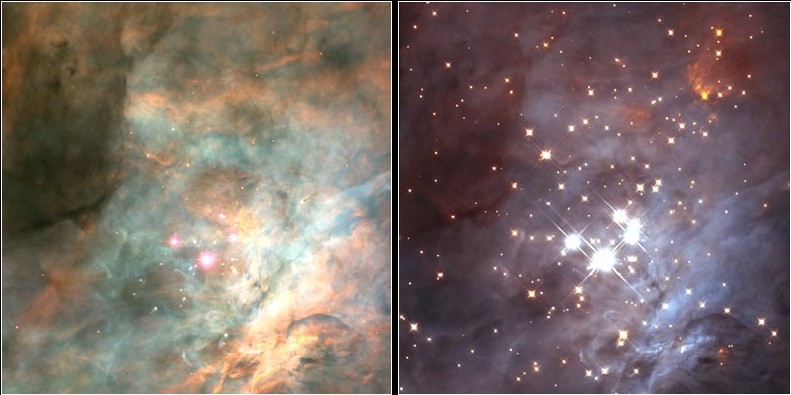
Two views of the Trapezium cluster in the Orion Nebula, from the Hubble Space Telescope.
The image on the left, an optical spectrum image taken with Hubble’s WFPC2 camera, shows a few stars shrouded in glowing gas and dust. On the right, an image taken with Hubble’s NICMOS infrared camera penetrates the haze to reveal a swarm of stars as well as brown dwarfs.Credits for near-infrared image: NASA; K.L. Luhman (Harvard-Smithsonian Center for Astrophysics, Cambridge, Mass.); and G. Schneider, E. Young, G. Rieke, A. Cotera, H. Chen, M. Rieke, R. Thompson (Steward Observatory, University of Arizona, Tucson, Ariz.) Credits for visible-light picture: NASA, C.R. O’Dell and S.K. Wong (Rice University)
